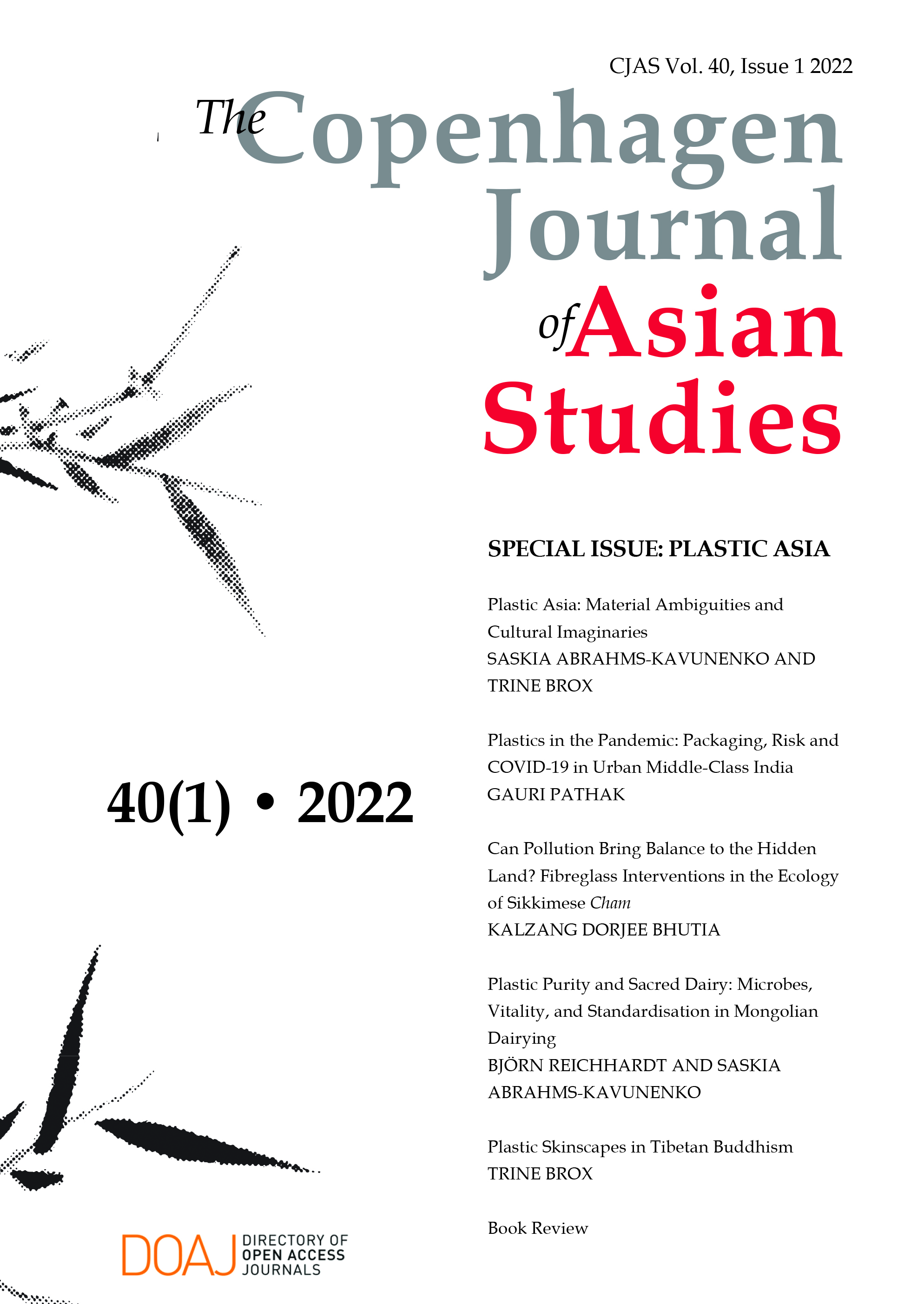Plastic Skinscapes in Tibetan Buddhism
DOI:
https://doi.org/10.22439/cjas.v40i1.6557Keywords:
acrylic, aesthetics, material religion, materials, permanence, pollution, polyethylene, siliconeAbstract
This article takes as its point of departure S. Brent Plate's (2012) compelling metaphor ‘the skin of religion’ to discuss the increasing presence and impact of plastics in the sphere of religion. What material and imagined properties of plastics allow them to be incorporated into the sacred domain? How are plastics experienced? What are the consequences of plastics’ increasing presence? The discussion pivots around observations of three forms of plastics used in contemporary Tibetan Buddhism: (1) acrylic shells protecting sacred text, (2) polyethylene jars containing votives and (3) silicone imitations of Buddhist lamas. The article focuses on the skinscapes co-constituted by these plastics, focusing on the affordances and enactments of plastics in the religious field, not only in terms of how acrylic, polyethylene and silicone are experienced, but also how they enact their material properties even beyond our sensual experiences of them. While the plastic materials protect and prolong the precious items that they contain or imitate, they also raise discussions about disposability, non-perishability, pollution and material doubt.
References
Abrahms-Kavunenko, Saskia 2021. ‘Toward an Anthropology of Plastics’. Journal of Material Culture (December): 1-21. https://doi.org/10.1177/13591835211066808.
Baffelli, Erica, Jane Caple, Levi McLaughlin and Frederik Schröer (eds.) 2021. ‘The Aesthetics and Emotions of Religious Belonging: Examples from the Buddhist World’ [special issue]. NUMEN 68 (5-6).
Barnes, David K. A., Francois Galgani, Richard C. Thompson and Morton Barlaz 2009. ‘Accumulation and Fragmentation of Plastic Debris in Global Environments’. Philosophical Transactions of The Royal Society B Biological Sciences 364 (1526): 1985-1998. https://doi.org/10.1098/rstb.2008.0205.
Bennett, Jane 2010. Vibrant Matter: A Political Ecology of Things. Durham and London: Duke University Press. https://doi.org/10.3917/rac.025.0839.
Bhutia, Kalzang Dorjee 2022. ‘Can Pollution Bring Balance to the Hidden Land? Fibreglass Interventions in the Ecology of Sikkimese Cham’. The Copenhagen Journal of Asian Studies 40 (1). https://doi.org/10.22439/cjas.v40i1.6558.
Brox, Trine 2020. ‘Tibetan Waxworks of the Living and the Dead’. Object Lessons from Tibet & the Himalayas 27 May 2020. https://objectlessonsfromtibetblog.wordpress.com/2020/05/27/tibetan-waxworks-of-the-living-and-the-dead/. (Accessed 28 December 2021).
Brox, Trine 2022. ‘A Framework for Studying Buddhism and Waste’. In T. Brox and E. Williams-Oerberg (eds.) Buddhism and Waste: The Excess, Discard and Afterlife of Buddhist Consumption. New York: Bloomsbury Academic, pp. 1-30.
Chao, Sophie 2018. ‘The Plastic Cassowary: Problematic “Pets” in West Papua’. Ethnos 84 (5): 828-848. https://doi.org/10.1080/00141844.2018.1502798.
Dey, Tridibesh and Mike Michael 2021. ‘Plastic Possibilities: Contrasting the Uses of Plastic ‘Waste’ in India’. Anthropology Today 37 (3): 11-15. https://doi.org/10.1111/1467-8322.12652.
Douglas, Mary 2002 [1966]. Purity and Danger: An Analysis of the Concepts of Pollution and Taboo. London: Routledge.
Gabrys, Jennifer 2009. 'Sink: The Dirt of Systems'. Environment and Planning D: Society and Space 27(4), 666-681. https://doi.org/10.1068/d5708.
Gabrys, Jennifer, Gay Hawkins and Mike Michael (eds.) 2013. Accumulation: The Material Politics of Plastic. New York: Routledge.
Hawkins, Gay 2001. ‘Plastic Bags: Living with Rubbish’. International Journal of Cultural Studies 4 (1): 5-23. https://doi.org/10.1177%2F136787790100400101.
Hawkins, Gay 2013. ‘Made to be Wasted: PET and Topologies of Disposability’. In J. Gabrys, G. Hawkins and M. Michael (eds.) Accumulation: The Material Politics of Plastic. New York: Routledge, pp. 49-67. https://doi.org/10.4324/9780203070215-12.
Hawkins, Gay 2018. ‘The Skin of Commerce: Governing through Plastic Food Packaging’. Journal of Cultural Economy 11 (5): 386-403. https://doi.org/10.1080/17530350.2018.1463864.
Ingold, Tim 2007. ‘Materials against Materiality’. Archaeological Dialogues 14 (1): 1-16. https://doi.org/10.1017/S1380203807002127.
Lefteri, Chris 2014. Materials for Design. London: Laurence King Publishing.
Liboiron, Max 2016. ‘Redefining Pollution and Action: The Matter of Plastics’. Journal of Material Culture 21 (1): 87-110. https://doi.org/10.1177/1359183515622966.
Meikle, Jeffrey L. 1997. ‘Material Doubts: The Consequences of Plastic’. Environmental History 2 (3): 278-300. https://doi.org/10.2307/3985351.
Meyer, Birgit 2009. ‘Introduction: From Imagined Communities to Aesthetic Formations: Religious Mediations, Sensational Forms, and Styles of Binding’. In B. Meyer (ed.) Aesthetic Formations: Media, Religion, and the Senses. New York: Palgrave Macmillan, pp. 1-28. https://doi.org/10.1057/9780230623248.
Meyer, Birgit and Jojada Verrips 2008. ‘Aesthetics’. In D. Morgan (ed.) Key Words in Religion, Media and Culture. London: Routledge, pp. 20-30.
Morton, Timothy 2013. Hyperobjects: Philosophy and Ecology after the End of the World. Minneapolis: University of Minnesota Press.
Namgyal-Lama, Kunsang 2013. Les tsha tsha du monde tibétain: études de la production, de l’iconographie et des styles des moulages et estampages bouddhiques. Ph.D. dissertation, Université de Paris-Sorbonne.
Panzanelli, Roberta 2008. ‘Introduction: The Body in Wax, the Body of Wax’. In R. Panzanelli (ed.) Ephemeral Bodies: Wax Sculpture and the Human Figure. Los Angeles: Getty Publications, pp. 1-11.
Pathak, Gauri 2020. ‘Permeable Persons and Plastic Packaging in India: From Biomoral Substance Exchange to Chemotoxic Transmission’. Journal of the Royal Anthropological Institute 26 (4): 751-765. https://doi.org/10.1111/1467-9655.13365.
Plate, S. Brent 2012. ‘The Skin of Religion: Aesthetic Mediations of the Sacred’. Cross-Currents: East Asian History and Culture Review 2012 (June): 162-80. 10.1111/j.1939-3881.2012.00228.x
Royer, Sarah-Jeanne, Sara Ferrón, Samuel T. Wilson and David M. Karl 2018. ‘Production of Methane and Ethylene from Plastic in the Environment.’ PloS ONE 13 (8): 1-13. https://doi.org/10.1371/journal.pone.0200574.
Williams-Oerberg, Elizabeth 2021. ‘Buddhist Ritual as “Connectionwork”: Aesthetics and Technologies of Mediating Religious Belonging’. NUMEN 68 (5-6): 488-512. https://doi.org/10.1163/15685276-12341637.


